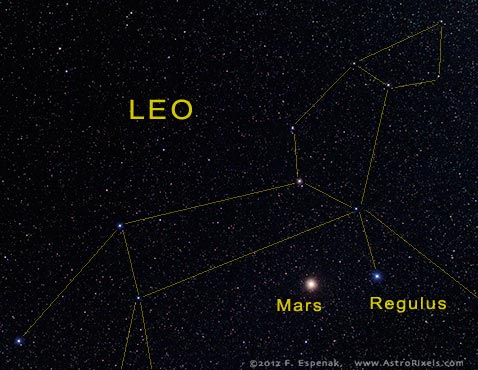
Leo and Mars - II
In the spring of 2012, the planet Mars was visible as a bright red/orange star in the constellation Leo. Over the course of several months, Mars' position slowly changed against the background stars of Leo.
In the image above, Mars is the very bright, reddish "star". To the west of Mars is Leo's brightest star Regulus. The diagram to the right illustrates the outline of Leo as well as the positions of Mars and Regulus.
Leo is a Zodiacal constellation otherwise known as the Lion. It is one of the 48 Greek constellations originally described by the 2nd century astronomer Claudius Ptolemy (Wikipedia). Leo remains one of the 88 modern constellations defined by the International Astronomical Union (Wikipedia).
Leo (abbrev. = Leo; genitive = Leonis) covers 947 square degrees or 2.30% of the celestial sphere making it the 12th largest constellation. It contains 123 stars brighter than apparent magnitude 6.5, the brightest star being Regulus. See the Leo Star Chartfor a figure illustrating this constellation including the identification of its brighter stars.
For more information see the entries for Leo at Wikipedia and U. Wisconsin. For a chart of Leo, see Leo (IAU).
For an almanac of other interesting sky happenings for each year, see Calendar of Astronomical Events.
Technical Details
- Object: Leo and Mars - II
- Date/Time: 2012 Apr 10 at 03:51 UTC
- Location: Bifrost Astronomical Observatory, Portal, AZ
- Mount: Losmandy G-11 German Equatorial Mount
- Lens: Nikkor AI 28mm f/2
- Camera: Canon EOS 550D (Rebel T2i)
- Field of View: 43.4° x 29.8° at 30.1 arc-sec/pixel (web version: 169 arc-sec/pixel)
- Exposure: 2 x 300s, f/5.6, ISO 800 and 120s, f/5.6, ISO 800 with Cokin A830 Diffusion Filter
- File Name: LeoMars-02w.jpg
- Processing (Adobe Camera Raw): Vignetting Correction, Noise Reduction, White Balance, Curves
- Processing (Photoshop CS5): Average Images, Curves, opacity (with diffusion image)
- Original Image Size: 3454 × 5179 pixels (17.9 MP); 11.5" x 17.3" @ 300 dpi
- Rights: Copyright 2012 by Fred Espenak. All Rights Reserved. See: Image Licensing.
